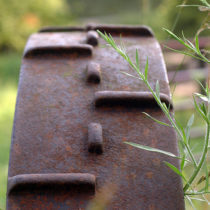Landscape Architecture for Landscape Architects › Forums › SUSTAINABILITY & DESIGN › edible landscaping
- This topic has 1 reply, 13 voices, and was last updated 16 years, 3 months ago by
 Kimberly.
Kimberly.
-
AuthorPosts
-
March 16, 2009 at 10:18 pm #175030
 Roland BeinertParticipant
Roland BeinertParticipantI guess when I used the word “bias” it was more confrontational than I intended. I chose that word because of some of the responses to the article in Landscape Architecture Magazine.
I am seeing trends in the use of edible plants these days that I think landscape architects could probably use to increase and broaden their business. People outside our profession are starting to explore these ideas, and it might not be a bad idea for us to, as well. Since that one short article in LAM, there has not been any discussion of edible plants.
I agree that there are situations where edible plants are NEVER a good idea, especially commercial areas and streetscapes. The idea could be useful in large parks and for residential clients, though. Perhaps landscape architects could be useful in helping people solve problems associated with edible plants.April 14, 2009 at 5:14 pm #175029 Wayne WilcoxParticipant
Wayne WilcoxParticipantVery interesting line of discussion. Here’s a rhapsody of thoughts after reading thru the posts …
1. I perceive a presupposition that landscape architecture is primarily about using plants to make a pretty place. Or to make a place pretty. LA is more complex than that, with multiple purposes, issues and criteria. We all know that, I hope, but sometimes it bears repeating.
2. Likewise, the issue of edibles in landscapes is more complicated than the like/dislike, good/bad, bias/open angles. For instance, different approaches are appropriate to different landscapes. Plantings that fit at a suburban office complex might not fit so well at a country estate. Plus, if people discover that some of the plantings at their local Burger King are edible, what’s to stop them from trying other plantings? Gee, that yew looks yummy. Hey, look, there’s some hemlock! Uh, oh.
Further, one important element of LA is that we are creating habitat, whether we’re paying attention to that or not. A lawn is a habitat, just like a forest. What biota does it support? How does our new habitat fit into its ecosystem context? Without implying that we should be anthropocentric, plants that are edible for humans can contribute in wonderful ways.
3. Even the best LAs have limited plant palletes. We can only know so much, and in the hustle of getting a project done, sometimes we must run with the palletes we know best. Adopting a principle that plantings can be edible might encourage us to explore new palletes, but in the work-a-day world, with my reputation and budget both on the line, sometimes I just gotta go with what I know will work.
4. Too many LA plans that I’ve seen (and some that I’ve drawn) focused on a limited set of issues: pick plants that survive; pick pretty plants; arrange them to look good; minimize maintenance. We can lose sight of the big picture sometimes.
5. Like Andrew G, I wrestle with who drives the values of a project. On the one hand, clients hire me because I know and understand things that they don’t. On the otehr hand, it’s their project, and they live with it after I finish with it.
Well, I’d thought that these disparate thoughts would weave into something coherent, but that doesn’t seem to have happened.
April 14, 2009 at 6:28 pm #175028 Vance W. HallParticipant
Vance W. HallParticipantI believe weeds are sometimes others flowers. The same can surely be said about food bearing plants.
In Denver we have an apartment manager near my office that does what he calls ” Inter-Urban Gardening”. He is a collector and a unique character to say the least , but what he does is very interesting. He will take a space of unused land in an alley or along a parking lot fence line and plant vegetables of all kinds in an ornate manner. He does it to help feed the many homeless he knows that populate the downtown area and to fulfill his need to garden. So as you are walking you will see a bunch of carrots , a few rows of corn or tomatoes. It looks good and replaces patches of dirt with food for thought.
Use those veggies or spices. With a recession who can’t use a little of natures goodness to add to the dinner table.
April 18, 2009 at 10:35 pm #175027 Roland BeinertParticipant
Roland BeinertParticipantAll good points. Some of my responses:
1. I agree that landscape architecture is about far more than shrubbing things up. However, this discussion is specifically about edible plants. There’s nothing about discussing plants that means any of the posters think we deal only with plants. I’m a bit worried that I took a confrontational approach with the original post, and so the whole discussion has devolved into people venting about their pet peeves. Let’s stick to discussing edible plants and example projects, and stop accusing each other. For the second time, I apologize for being confrontational in the original post.
Can you point out what is was that made you think this?2. I also agree that different landscapes require a different approach, and that liability is always an issue with anything we do. I think edible plants belong in places where people are likely to eat what the plants produce. There are plenty of places where they would likely be ignored or where the fallen fruit could be a nuisance (then again non-edible fruit can be a nuisance, too). But I think they could be included in places where they are traditionally ignored, and people might actually be very open to the idea.
In your Burger King example, I’d say the designer would need to make it clear what was edible and not edible by the placement of the plants and maybe with informative signs. In a residentail setting it’s easier to mix edible and non-edible plants, since the client is more likely to request certain plants and know where things are. I’d also say that poisonous plants are a liability even if they are not used next to food plants.
I completely agree that we are creating habitat with our landscapes, and I think sometimes we over-emphasize reacreation and aesthetics. I’m not saying those things aren’t important. What I’m saying is that by including food growing areas we reinforce the importance of landscapes. It’s not quite as easy to trash the environment when you know your food comes from it.3. I understand that we all have to limit our plant pallettes. However, I think it’s a good idea to have plant pallettes for different situations, if your clients are diverse enough. If you only do commercial and institutional landscapes, maybe food plants aren’t as important. If you do a little bit of everything, maybe it’s important to have a pallette of traditional landscape plants, plus one of natives, plus one of food plants, etc. At the first place I worked we had a list of plants divided up based on type, size and water requirements and origin (native vs. not). I’m sure my boss had to put a lot of effort into making that list, but it sure made things easier.
4. I think it is easy to lose sight of the big picture when projects have to be rushed (which they usually do). I guess all you can do is have a diverse set of principles that allows you to respond to different situations in a way you think is appropriate.
5. The idea of edible plants in the landscape isn’t being driven by landscape architects. It’s being driven by an increased awareness of where our food comes from and worries about health and food costs. If you take advantage of that, it doesn’t mean you are forcing your values. The lesson I learned from my first work place is that if you portray yourself as someone who knows about food plants or sustainable design or whatever, you will get clients who request it. Not every client will, but you take what you can. For clients who don’t request it, you can suggest using food plants once without making making them mad, if you can support your suggestion.
Having your own values is not the same thing as forcing them on clients. We all have them, anyway.April 18, 2009 at 10:49 pm #175026 Roland BeinertParticipant
Roland BeinertParticipantIt’s cool that Monrovia is doing that. What are some project examples? I remember at my first work place, my boss had a demonstration garden with some of those thronless blackberries. It was nice walking past on my way to the office and grabbing some, but, unfortunately, I usually didn’t get to them before other people or birds ate them.
April 20, 2009 at 11:18 pm #175025 Teri HaleParticipant
Teri HaleParticipanthello all,
Wow, what a great way to use space that is otherwise going to waste—love the idea. We have some areas in my city where you will see some of that sort of thing, but no one has done it in alleys yet. Ours are mostly a corner of a parking lot, or a spot contrived by man and you need to rent the plots to garden in.I can see how a front yard garden may get scraggly or messy, just needs more care and planning to look good. I much prefer the idea to large tracks of grass myself.
for garden tours and more….all inclusive vacations
April 21, 2009 at 1:17 pm #175024 Anne RobertParticipant
Anne RobertParticipantIf you are interested in edible gardens you may like the Idea in the UK
landshare.co.uk : basically it is a swap system: you have skill no land in town and I have a terrace but no skills : you use my plot to grow food and share produce. 100 000 ‘deals are already ‘ agreed !
AnneApril 22, 2009 at 5:05 am #175023 Tim MartenParticipant
Tim MartenParticipantYes….. But having a grasp on Permaculture helps when understanding where jacke is coming from and going to
April 27, 2009 at 1:05 pm #175022 Wayne WilcoxParticipant
Wayne WilcoxParticipantVery thoughtful.
1. I’d have to deconstruct my observations to reply carefully. Suffice it to say that several posts triggered the thought.2. Agreed.
3. I did something similar but with a twist. I got burned several times by spec’ing plants out of Dirr and similar books, only to discover that they’re not commercially available. Contractors couldn’t find ’em. So I visited the Virginia Nursery & Landscape Association website, downloaded the database of plants that growers were growing, and then spent too much time sorting them by different criteria. Now I can spec plants that I KNOW are easily commercially available by referring to my cheat sheet.
4. Agreed.
5. I hope you’re right about getting clients who want your particular approach. I’m aiming for a natives niche, but I’m not sure that this market will support that.
April 27, 2009 at 5:14 pm #175021 Roland BeinertParticipant
Roland BeinertParticipantI’ve heard of similar programs in San Francisco. It’s a great idea.
-
AuthorPosts
- You must be logged in to reply to this topic.


